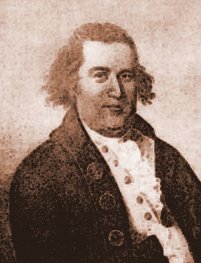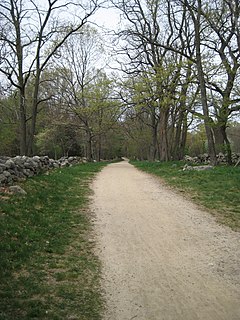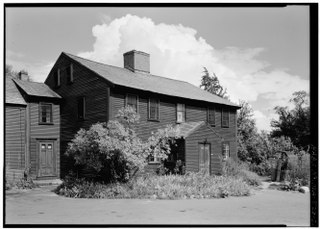
William Dawes Jr. was one of several men who in April 1775 alerted colonial minutemen in Massachusetts of the approach of British army troops prior to the Battles of Lexington and Concord at the outset of the American Revolution. For some years, Paul Revere had the most renown for his ride of warning of this event.

Samuel Prescott was an American physician and a Massachusetts Patriot during the American Revolutionary War. He is best known for his role in Paul Revere's "midnight ride" to warn the townspeople of Concord, Massachusetts of the impending British army move to capture guns and gunpowder kept there at the beginning of the American Revolution. He was the only participant in the ride to reach Concord.

Minute Man National Historical Park commemorates the opening battle in the American Revolutionary War. It also includes the Wayside, home in turn to three noted American authors. The National Historical Park is under the jurisdiction of the National Park Service and protects 970 acres (392.5 ha) in and around the Massachusetts towns of Lexington, Lincoln, and Concord.

Buckman Tavern is a historic American Revolutionary War site associated with the revolution's very first battle, the 1775 Battle of Lexington and Concord. It is located on the Battle Green in Lexington, Massachusetts and operated as a museum by the Lexington Historical Society.

The Battles of Lexington and Concord were the first military engagements of the American Revolutionary War. The battles were fought on April 19, 1775, in Middlesex County, Province of Massachusetts Bay, within the towns of Lexington, Concord, Lincoln, Menotomy, and Cambridge. They marked the outbreak of armed conflict between the Kingdom of Great Britain and its thirteen colonies in America.

Isaac Davis was a gunsmith and a militia officer who commanded a company of Minutemen from Acton, Massachusetts, during the first battle of the American Revolutionary War. In the months leading up to the Revolution, Davis set unusually high standards for his company in terms of equipment, training, and preparedness. His company was selected to lead the advance on the British Regulars during the Battle of Concord because his men were entirely outfitted with bayonets. During the American advance on the British at the Old North Bridge, Davis was among the first killed and was the first American officer to die in the Revolution.

John Robinson was a Massachusetts militia and Continental Army officer from Westford, Massachusetts during the American Revolutionary War. On April 19, 1775, during the Battle of Concord, Robinson was the second highest-ranking officer in the field after Colonel James Barrett. Robinson marched next to Major John Buttrick at the head of the American column which advanced on and defeated the British Regulars at the Old North Bridge that day. Robinson would later fight at the Battle of Bunker Hill, serve under General George Washington during the Siege of Boston and, in 1786, he would take part in the agrarian insurrection known as Shays' Rebellion.

Battle Road, formerly known as the Old Concord Road and the Bay Road, is a historic road in Massachusetts, United States. It was formerly part of the main road connecting Lexington, Lincoln and Concord, three of the main towns involved in the American Revolutionary War. It was on Battle Road that thousands of colonial militia and British regulars fought during the redcoats' retreat from Concord to Boston on the morning and afternoon of April 19, 1775.
Thaddeus Bowman was the last scout sent out by Capt. John Parker at Lexington, Massachusetts, but the only one to find the approaching British troops and get back to warn the militia on the first day of the American Revolution.
Capt. John Trull (1738–1797) was the commander of the Tewksbury, Massachusetts minuteman company on the first day of the American Revolution, at the Battle of Lexington & Concord.

Hartwell Tavern is a historic American Revolutionary War site associated with the revolution's first battle, the 1775 battles of Lexington and Concord. It is located on North County Road, just off Battle Road in Lincoln, Massachusetts, and operated as a historic house museum by the National Park Service as part of the Minute Man National Historical Park. Built in 1733, in what was then Concord, it is staffed from Memorial Day (May) weekend to October by park rangers dressed in colonial attire who offer programs daily.

The Midnight Ride was the alert to the American colonial militia in April 1775 to the approach of British forces before the battles of Lexington and Concord.

The Samuel Hartwell House is a historic American Revolutionary War site associated with the revolution's first battle, the 1775 battles of Lexington and Concord. Built in 1733, in what was then Concord, it was located on North County Road, just off Battle Road in today's Lincoln, Massachusetts, and about 700 feet east of Hartwell Tavern, which Hartwell built for his son, Ephraim, and his newlywed wife, Elizabeth, in 1733. The site is part of today's Minute Man National Historic Park.

The Captain William Smith House is a historic American Revolutionary War site in Lincoln, Massachusetts, United States. Part of today's Minute Man National Historic Park, it is associated with the revolution's first battle, the 1775 battles of Lexington and Concord. Believed to have been built in 1692, in what was then Concord, it is believed to be the oldest house in Lincoln.

The Job Brooks House is a historic American Revolutionary War site in Lincoln, Massachusetts, United States. It is part of today's Minute Man National Historic Park.

The Jacob Whittemore House is a historic American Revolutionary War site in Lexington, Massachusetts, United States. It is part of today's Minute Man National Historic Park. It is located on Airport Road, just off Battle Road. It is the only house of the "witness" houses of the April 19, 1775 battles of Lexington and Concord to fall inside the Lexington town line; the others are in Lincoln or Concord.

Virginia Road, also known as North County Road, North Country Road and Bay Road, is a historic road in Lincoln, Massachusetts, United States. It was part of Concord, Massachusetts, until 1754. Today, it is in the care of the Minute Man National Historical Park.
The Bloody Angle refers to a section of the Battle Road, in Lincoln, Massachusetts, on which two battles were fought on April 19, 1775, during the battles of Lexington and Concord in the first stage of the American Revolutionary War. The stretch of the mainly east–west-running road turns north for about 500 yards (460 m) and then east, as per the direction of travel during the British regulars' retreat from nearby Concord to Boston.

The Noah Brooks Tavern is a historic American Revolutionary War site associated with the revolution's first battle, the 1775 battles of Lexington and Concord. It stands, on the site of a previous home, on North Great Road in Lincoln, Massachusetts, just south of the former Battle Road, in an area known as Brooks Village. It is one of eleven houses within the Minute Man National Historic Park that still exists today.
Brooks Hill is a location that featured in the battles of Lexington and Concord on April 19, 1775. It was here that the British regulars passed on their marches to Concord from Boston and again on their retreat east. It has also been referred to as Hardy's Hill.















